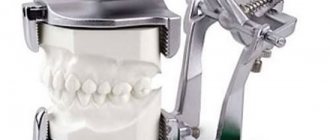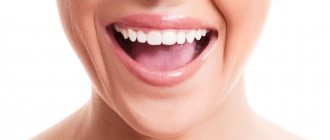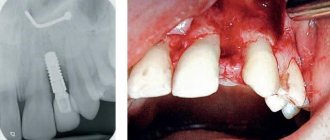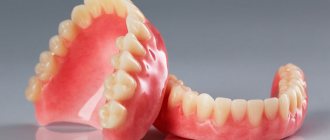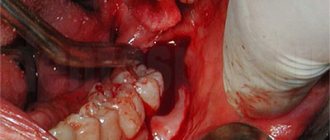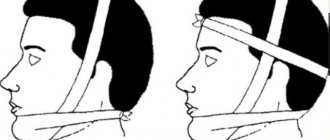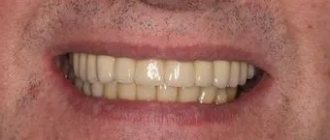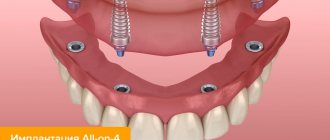Scheme of forward and downward movements of the heads of the lower jaw
The TMJ provides a distal fixed position of the lower jaw in relation to the upper jaw and creates guiding planes for its movement forward, sideways and downward within the boundaries of movement. In the absence of contact between the teeth, the movements of the lower jaw are directed by the articulating surfaces of the joints and proprioceptive neuromuscular mechanisms. Stable vertical and distal interaction of the lower jaw with the upper jaw is ensured by the intertubercular contact of the antagonist teeth. The cusps of the teeth also form guide planes for the movement of the lower jaw forward and laterally within the contacts between the teeth. When the mandible moves and the teeth are in contact, the chewing surfaces of the teeth direct the movement and the joints play a passive role.
Vertical movements that characterize the opening of the mouth are carried out with active bilateral contraction of the muscles running from the lower jaw to the hyoid bone, as well as due to the gravity of the jaw itself.
Movement of the lower jaw when opening the mouth
There are three phases in mouth opening: slight, significant, maximum. The amplitude of the vertical movement of the lower jaw is 4-5 cm. When closing the mouth, the lifting of the lower jaw is carried out by simultaneous contraction of the muscles that lift the mandible. In this case, in the TMJ, the heads of the lower jaw rotate together with the disk around its own axis, then down and forward along the slope of the articular tubercles to the apexes when opening the mouth and in the reverse order when closing.
Sagittal movements of the lower jaw characterize the advancement of the lower jaw forward, i.e. a complex of movements in the sagittal plane within the boundaries of movement of the interincisal point.
The forward movement of the lower jaw is carried out by bilateral contraction of the lateral pterygoid muscles, partially the temporal and medial pterygoid muscles. The movement of the head of the mandible can be divided into two phases. In the first, the disc together with the head slides along the surface of the articular tubercle. In the second phase, the sliding of the head is accompanied by its articulated movement around its own transverse axis passing through the heads. The distance that the head of the mandible travels when it moves forward is called the sagittal articular path. It is on average 7-10 mm. The angle formed by the intersection of the line of the sagittal articular path with the occlusal plane is called the angle of the sagittal articular path. Depending on the severity of the articular tubercle and the tubercles of the lateral teeth, this angle varies, but on average (according to Gisi) it is 33°.
Biomechanics of the lower jaw during movement from central to anterior occlusion: O-O1 - sagittal articular path, M-M1 - sagittal path of the molar, P-P1 - sagittal incisal path; 1 - angle of the sagittal articular path, 2 - angle of the sagittal incisive path, 3 - separation (disocclusion between molars)
The sagittal occlusal curve (Spee curve) runs from the upper third of the distal slope of the lower canine to the distal buccal cusp of the last lower molar. When the lower jaw is advanced, due to the presence of a sagittal occlusal curve, multiple interdental contacts arise, ensuring harmonious occlusal relationships between the dentition. The sagittal occlusal curve compensates for the unevenness of the occlusal surfaces of the teeth and is therefore called the compensatory curve. In a simplified way, the mechanism of movement of the lower jaw is as follows: when moving forward, the head of the condylar process moves forward and down along the slope of the articular tubercle, while the teeth of the lower jaw also move forward and down. However, when encountering the complex relief of the occlusal surface of the upper teeth, they form continuous contact with them until the separation of the dentition occurs due to the height of the central incisors. It should be noted that during sagittal movement, the central lower incisors slide along the palatal surface of the upper ones, passing the sagittal incisal path. The angle formed by the vector of the incisal path and the occlusal plane. Depending on the elevation of the central incisor tubercles, this angle varies, but on average it is 40-50°. Thus, the harmonious interaction between the cusps of the chewing teeth, the incisive and articular tracts ensures the preservation of tooth contacts when the lower jaw is advanced. If the curvature of the sagittal compensatory occlusal curve is not taken into account in the manufacture of removable and fixed dentures, overload of the articular discs occurs, which will inevitably lead to TMJ disease.
The relationship between the sagittal articular and sagittal incisive tracts
Transversal (lateral) movements of the lower jaw are carried out as a result of predominantly unilateral contraction of the lateral pterygoid muscle. When the lower jaw moves to the right, the left lateral pterygoid muscle contracts and vice versa. In this case, the head of the lower jaw on the working side (displacement side) rotates around a vertical axis. On the opposite balancing side (the side of the contracted muscle), the head of the mandible slides along with the disc along the articular surface of the tubercle downward, forward and somewhat inward, making a lateral articular path. The angle formed between the lines of the sagittal and transverse articular path is called the angle of the transversal articular path. In the literature it is known as the “ Bennett angle ” and is equal, on average, to 17°. Transversal movements are characterized by certain changes in the position of the teeth. The curves of the lateral movements of the anterior teeth at the interincisal point intersect at an obtuse angle. This angle is called the Gothic or transversal incisal path angle . It determines the span of the incisors during lateral movements of the lower jaw and is on average 100-110°.
Vertical movement of the lower jaw.
The initial position of the lower jaw when opening the mouth is the state when the lips are closed. In this case, there is a gap of 2-4 mm between the dentition of the lower jaw and the upper jaw. This state is called a state of physiological rest. The movement of the lower jaw in the vertical plane occurs when opening and closing the mouth, due to the active contraction of the muscles: - depressors (mylohyoid, geniohyoid, anterior belly of the digastric muscle) - levator (proper masticatory muscle, temporalis, medial pterygoid muscle). The amplitude of mouth opening is strictly individual. On average it is 4-5 cm.
Phases of lowering the lower jaw.
1. With a slight lowering of the lower jaw (quiet speech, drinking), the articular heads in the infero-posterior part of the joint rotate around a horizontal axis passing through their centers. 2. With a significant lowering of the lower jaw (loud speech, biting), the hinge rotation in the infero-posterior part of the joint is joined by sliding of the articular heads together with the discs forward along the circumference of the articular surface. The result is a combined movement of the articular heads, in which the point of contact of two convex articular surfaces moves. 3. With the maximum lowering of the lower jaw, the sliding of the heads is delayed at the apex by the tension of the articular capsules, articular ligaments and muscles, and one hinge movement continues in the joint. The trajectories of movement of the lower teeth are concentric curves with a common center in the head of the lower jaw. They, just like the axis of rotation of the head, can move in space.
Lateral movements of the lower jaw (Gothic angle - 110° and Bennett angle - 17°)
These data are necessary for programming the articular mechanisms of devices that simulate the movements of the lower jaw. On the working side, the lateral teeth are positioned relative to each other by tubercles of the same name; on the balancing side, the teeth are in an open state.
The nature of the closure of chewing teeth in left lateral occlusion: a - balancing and b - working sides
It is known that the chewing teeth of the upper jaw have an axis inclined towards the buccal side, and the lower teeth - towards the lingual side. Thus, a transverse occlusal curve is formed, connecting the buccal and lingual tubercles of the chewing teeth of one side with the same tubercles of the other side. In the literature, the transversal occlusal curve is called the Wilson curve and has a radius of curvature of 95 mm. As noted above, during lateral movements of the mandible, the condylar process on the balancing side moves forward, down and inward, thereby changing the plane of inclination of the jaw. In this case, the antagonist teeth are in continuous contact, the opening of the dentition occurs only at the moment of contact of the fangs. This type of opening is called “canine guidance.” If, at the moment of opening the molars on the working side, the canines and premolars remain in contact, this type of opening is called “canine-premolar guidance.” When making fixed dentures, it is necessary to establish what type of opening is typical for a given patient. This can be done by focusing on the opposite side and the height of the fangs. If this cannot be done, it is necessary to make a prosthesis with canine-premolar guidance. In this way, overloading of periodontal tissues and articular discs can be avoided. Compliance with the radius of curvature of the transversal occlusal curve will help to avoid the occurrence of supercontacts in the chewing group of teeth during lateral movements of the lower jaw.
The central relationship of the jaws is the starting point of all movements of the lower jaw and is characterized by the highest position of the articular heads and the tubercular contact of the lateral teeth.
Mouth opening (A) from the position of centric relation (B) and central occlusion (C)
The mandible then slides to a more stable position where maximum fissure-tubercle contact is achieved. The sliding of teeth (within 1 mm) from the position of the centric relation to the central occlusion is directed forward and upward in the sagittal plane, it is otherwise called “sliding along the center.”
Movement of the lower jaw from centric relation (A) to centric occlusion (B)
When the teeth are closed in central occlusion, the palatal tubercles of the upper teeth come into contact with the central fossae or marginal projections of the lower molars and premolars of the same name. The buccal cusps of the lower teeth are in contact with the central fossae or marginal projections of the same upper molars and premolars. The buccal cusps of the lower teeth and the palatal cusps of the upper teeth are called “supporting” or “retaining”, the lingual cusps of the lower and buccal cusps of the upper teeth are called “guide” or “protective” (protect the tongue or cheek from biting).
Functional purpose of the tubercles: 1 - buccal tubercle of the upper molar - protective; 2 - palatal tubercle of the upper molar - supporting; 3 - buccal tubercle of the lower molar - protective; 4 - lingual tubercle of the lower molar - protective
When the teeth are closed in central occlusion, the palatal tubercles of the upper teeth come into contact with the central fossae or marginal projections of the lower molars and premolars of the same name. The buccal cusps of the lower teeth are in contact with the central fossae or marginal projections of the same upper molars and premolars. The buccal cusps of the lower teeth and the palatal cusps of the upper teeth are called “supporting” or “retaining”, the lingual cusps of the lower and buccal cusps of the upper teeth are called “guide” or “protective” (protect the tongue or cheek from biting).
Percentage ratio of supporting and guiding tubercles
During chewing movements, the lower jaw should slide freely along the occlusal surface of the teeth of the upper jaw, i.e. the tubercles should smoothly slide along the slopes of the antagonist teeth without disturbing the occlusal relationship. At the same time, they must be in close contact. On the occlusal surface of the first lower molars, the sagittal and transversal movements of the lower jaw are reflected by the arrangement of longitudinal and transverse fissures, which is called the “ occlusal compass ”. This landmark is very important when modeling the occlusal surface of teeth.
Sagittal movements of the lower jaw.
The forward movement of the lower jaw is carried out by bilateral contraction of the lateral pterygoid muscles. The movement of the head of the lower jaw is divided into 2 phases: 1- the disc together with the head slides along the surface of the articular tubercle; 2- the sliding of the head is accompanied by its articulated movement around its own transverse axis. The distance that the head of the mandible travels when it moves forward is called the sagittal articular path. This distance is on average 7-10 mm. The angle formed by the intersection of the line of the sagittal articular path with the occlusal plane is called the angle of the sagittal articular path. According to Gisi, it averages 33º. With an orthognathic bite, the protrusion of the lower jaw is accompanied by sliding of the lower incisors along the palatal surface of the upper ones. The path taken by the lower incisors when moving the lower jaw forward is called the sagittal incisal path. The angle formed by the intersection of the line of the sagittal incisal path with the occlusal plane is called the angle of the sagittal incisal path. On average, its value is 40-50°. Bonneville's three-point contact. When the lower jaw is advanced to the position of anterior occlusion, contact of the dentition is possible only at three points. Two of them are located on the distal cusps of the second and third molars, and one on the anterior teeth.
Vertical and sagittal movements of the lower jaw. Articular and incisal gliding path.
Vertical movements of the lower jaw correspond to the opening and closing of the mouth. It is typical for opening the mouth and introducing food into the mouth that at this moment the selected optimal action option is triggered, depending on the visual analysis of the nature of the food and the size of the food bolus. So, a sandwich, seeds are placed in the incisor group, fruits, meat - closer to the canine, nuts - to the premolars. Thus, when the mouth opens, a spatial displacement of the entire lower jaw occurs (Fig. 33).
Depending on the amplitude of mouth opening, one or another movement predominates. With slight opening of the mouth (whispering, quiet speech, drinking), rotation of the head around the transverse axis in the lower part of the joint predominates; with a more significant opening of the mouth (loud speech, biting food), the rotational movement is joined by the sliding of the head and disc along the slope of the articular tubercle down and forward. With maximum mouth opening, the articular discs and mandibular heads are installed on the tops of the articular tubercles. Further movement of the articular heads is delayed by the tension of the muscular and ligamentous apparatus, and again only rotational or hinge movement remains. The movement of the articular heads when opening the mouth can be observed by placing the fingers in front of the tragus of the ear or inserting them into the external auditory canal. The amplitude of mouth opening is strictly individual. On average, it is 4-5 cm. The dentition of the lower jaw describes a curve when opening the mouth, the center of which lies in the middle of the articular head (Fig. 34). Each tooth also describes a certain curve (Fig. 35).
Sagittal movements of the lower jaw. The forward movement of the mandible is carried out mainly due to bilateral contraction of the lateral pterygoid muscles and can be divided into two phases: in the first, the disc together with the head of the mandible slides along the articular surface of the tubercle, and then in the second phase a hinge movement is added around the transverse axis passing through the heads. This movement occurs simultaneously in both joints. The distance that the articular head travels is called the sagittal articular path. This path is characterized by a certain angle, which is formed by the intersection of a line that is a continuation of the sagittal articular path with the occlusal (prosthetic) plane. The latter is understood as a plane passing through the cutting edges of the first incisors of the lower jaw and the distal buccal cusps of the last molars (Fig. 36). The angle of the sagittal articular path is individual and ranges from 20 to 40°, but its average value, according to Gysi, is 33°.
This combined pattern of movement of the lower jaw is found only in humans. The magnitude of the angle depends on the inclination, the degree of development of the articular tubercle and the amount of overlap by the upper anterior teeth of the lower anterior teeth. With deep overlap, rotation of the head will predominate; with small overlap, sliding will prevail. With a direct bite, the movements will be mainly sliding. Moving the lower jaw forward with an orthognathic bite is possible if the incisors of the lower jaw come out of the overlap, that is, the lowering of the lower jaw must first occur. This movement is accompanied by sliding of the lower incisors along the palatal surface of the upper ones until direct closure, that is, until anterior occlusion. The path taken by the lower incisors is called the sagittal incisal path. When it intersects with the occlusal (prosthetic) plane, an angle is formed, which is called the angle of the sagittal incisal path (Fig. 37 and 33).
It is also strictly individual, but, according to Gysi, it is in the range of 40-50°. Since during movement the mandibular articular head slides down and forward, the back part of the lower jaw naturally moves down and forward by the amount of incisal sliding. Consequently, when lowering the lower jaw, a distance between the chewing teeth should be formed equal to the amount of incisal overlap.
11. Transversal movements of the lower jaw. The concept of working and balancing sides. Phases of chewing movements of the lower jaw.
Transverse (lateral) movements of the mandible occur as a result of unilateral contraction of the lateral pterygoid muscle. When moving to the right, the left lateral pterygoid muscle contracts, and when moving to the left, the right muscle contracts.
During the transversal movement of the lower jaw, two sides are distinguished: working and balancing.
Laterotrusion (working movement) is the movement of the lower jaw from the position of central occlusion or central ratio in the direction of the working side, in which it deviates outward from the midsagittal plane.
Working side ( laterotrusive side) – the side towards which the movement of the lower jaw is directed from the position of central occlusion or centric relation.
Mediotrusion (non-working movement) is a movement of the lower jaw in which it deviates towards the midsagittal plane.
Non-working side (balancing, mediotrusive) - the side opposite (contralateral) to the working side when performing a working movement.
On the working side, where the movement of the jaw is directed, the chewing antagonist teeth are installed with identical tubercles, and on the opposite (balancing) side - with opposite ones. On the working side, the head remains in the hole and rotates only around its vertical axis. On the balancing side, the head together with the disc slides along the surface of the articular tubercle down and forward, as well as inward, forming an angle with the original direction of the line of the sagittal articular path. This angle was first described by Bennett and is called the angle of the transversal articular path (LATERAL ARTICULAR ANGLE ( Bennett's angle ), which is 15-20° (Fig. 37). It is depicted as a projection of two straight lines onto the Frankfort horizontal line.
Rice. 38. Angle of the transversal articular path (Bennett's movement).
Transversal movements are characterized by certain changes in the position of the teeth. If you graphically depict the curves of tooth movement during alternate movement of the lower jaw to the right and left, then they intersect at an obtuse angle. The farther the tooth is from the head, the greater the angle. The most obtuse angle is formed from the intersection of curves formed by the movement of the central incisors. This angle is called GOTHIC or TRANSVERSAL (LATERAL) INCISIVE PATH ANGLE and is on average 100 - 110°. It determines the span of the incisors during lateral movements of the lower jaw (Fig. 39).
The gothic angle recording is used to determine the centric relation of the jaws and centric occlusion.
Fig.39. Transversal incisal path.
The full range of movements of the mandible can be illustrated by a diagram showing the spatial movement of the midpoint between the central lower incisors. A three-dimensional image of the trajectory of movement of this point, obtained by U. Posselt by superimposing lateral radiographs of the skull, clearly demonstrates the complexity of the movements of the lower jaw (Fig. 40).
Rice. 40. Three-dimensional image of a complex of functional movements
lower jaw according to U. Posselt.
When chewing, the lower jaw undergoes a cycle of movements accompanied by the appearance of rapid sliding contacts of the teeth on the working side. Maximum chewing forces develop in the position of central occlusion. There are four phases of chewing. In the first phase, the jaw lowers and moves forward. In the second, the jaw shifts to the side (lateral movement). In the third phase, the teeth close on the working side with like-named tubercles, and on the balancing side with opposite ones. However, there may be no contact between the teeth on the balancing side, which depends on the severity of the transversal occlusal curves. In the fourth phase, the teeth return to the position of central occlusion (Fig. 41).
Rice. 41. Cycle of chewing movements according to U. Posselt.
The shape of the chewing cycle can be different depending on the degree of overlap and inclination of the front teeth, the height of the cusps of the chewing teeth, etc. In this regard, horizontal and vertical forms of the chewing cycle are distinguished (Fig. 42). The volume of movements of the lower jaw necessary to carry out the chewing cycle is, as a rule, less than the volume of all possible movements.
a b
a - horizontal form of the chewing cycle; b - vertical form of the chewing cycle.
Rice. 42. Forms of the chewing cycle according to U. Posselt.
Gothic arc . When viewed from above, the movements of the lower jaw in the horizontal plane during its extending right and left lateral movements to the limit, the trajectory of the midpoint of the lower incisors resembles an arrowhead or an arch. The top of this arc corresponds to the position of the central relation. The sides of the arc correspond to the trajectory of rotation of the midpoint of the lower incisors around the vertical axes of the working articular heads during the right and left lateral movements of the lower jaw to the limit.
The relationship between the sagittal incisal and articular tracts and the nature of occlusion has been studied by many authors. Bonneville, based on his research, derived the laws that are the basis for the construction of anatomical aritculators.
Bonneville's triangle is the relationship between the incisal point and the right and left heads of the temporomandibular joint. This is an equilateral triangle with a side length of about 10.5 cm. It is the basis for articulators tuned to average anatomical parameters. Considering the movements of the lower jaw carried out by the muscles of the maxillofacial region, three groups of muscle movements can be distinguished:
- conscious movements - moving the lower jaw forward, consciously opening the mouth;
- reflex movements - mandibular reflex, mouth opening reflex;
- rhythmic movements - chewing, articulation.
Chewing movements are complex, they include movements of the jaws, chewing and facial muscles and tongue, and soft tissues of the face. The lips, cheeks and tongue control the position of the bolus of food in the oral cavity and its retention on the occlusal surface. The following phases of the chewing cycle are distinguished:
1. preparatory phase - formation and preparation of the food bolus for crushing.
2. grinding phase - crushing and grinding the food bolus, mixing it with saliva on the working side (laterotrusive).
3. final formation of the food bolus before swallowing - mixing of the food bolus with saliva.
In all phases of the chewing cycle, the following movements are distinguished: group and working guiding functions, canine guidance.
Working guiding function (teeth-directed lateral movement of the lower jaw from the position of central occlusion) - the lateral movement of the lower jaw from the position of central occlusion with the teeth closed is directed by the contacting surfaces of these teeth on the working side. In natural dentition, two types of working guiding function are most often found: “canine path” and “group guiding function”.
Group guiding function (unilateral protection) - contact of the buccal cusps of molars and premolars in lateral occlusion on the working sides. Occurs in 16.3% of cases.
The canine path is the sliding of the apex or distobuccal slope of the lower canine of the working side along the palatal slope of the upper canine of the working side when the muscles move the lower jaw to the working side. This causes the lower jaw to move sideways, forward, and open the mouth. During the canine-guided working movement, the central and lateral incisors of the working side can simultaneously be in movable contact with the opposing central and lateral incisors. In a canine-guided working movement, the premolars and molars on the working side are opened while the mandible moves away from the centric occlusion position. All teeth on the non-working side open during this movement. The canine tract provides the anterior guide component, and the articular tract constitutes the distal guide component and provides the opening of the teeth on the non-working side. The canine route occurs in 57%.
Canine protection - contact of the canines in lateral occlusion on the working sides.
Anterior guiding function (incisal path) - When the incisors and canines guide both the forward and working movements of the mandible, they constitute the anterior guiding component of its movements.
Group working guiding function - the working guiding function of a group of teeth is carried out by all teeth of the working side. The cutting edges of the anterior teeth of the lower jaw slide along the palatal surfaces of the anterior teeth of the upper jaw. The buccal slopes of the buccal cusps of the lower premolars and immolars slide along the palatal slopes of the buccal cusps of the upper premolars and molars.
Chewing phases:
1) the phase of grasping and cutting food, which is characterized by sliding of the cutting edges of the lower frontal teeth along the palatal surface of the upper ones until their marginal closure and back; in this phase, the forward movement of the lower jaw predominates and, therefore, the teeth are set in anterior occlusion;
2) the phase of crushing food, which is carried out by the vertical movement of the lower jaw and is characterized by maximum contact of the teeth of both jaws; occlusion of the dentition in this phase is called central and is the initial and final moment of all chewing movements of the lower jaw;
3) the phase of grinding food, which is characterized by alternating movements of the lower jaw to the sides, and when the lower jaw moves in any direction on this side, the cusps of the chewing teeth of the lower jaw will contact the cusps of the same name in the upper jaw (buccal with buccal, palatal with lingual).
Movements of the lower jaw, bite and occlusal contacts of teeth
Opening the mouth. The initial position of the lower jaw when opening the mouth is the state when the lips are closed. At the same time, there is a gap of 2-4 mm between the dentition of the lower and upper jaw. This state is called a state of physiological rest.
The lowering of the lower jaw is carried out under the weight of the bone itself and bilateral contraction of muscles: the jaw - the hyoid muscle, the chin - the hyoid muscle, the anterior belly of the digastric muscle. There are 3 phases in the lowering of the lower jaw - slight, significant and maximum lowering. This corresponds to 3 types of movement of the articular heads.
A slight lowering of the lower jaw (quiet speech, drinking) occurs when its head moves in relation to the disc in the “lower floor” of the temporomandibular joint. In this case, identical movements simultaneously occur in the right and left joints along axes running along the greatest length of the ellipsoidal head of the lower jaw, and the midpoint of the central lower incisors describes an arc about 20 mm long.
With a significant lowering of the lower jaw (loud speech, biting) and hinge rotation in the “lower floor” of the joint, the articular heads, together with the discs, slide forward along the circumference of the articular surface, i.e. movement also occurs in the “upper floor” of the joint.
With the maximum lowering of the lower jaw, the sliding of the heads is delayed at the top of the articular tubercle by the tension of the articular capsules, articular ligaments and muscles. In this case, the midpoint of the lower incisors describes an arc up to 50 mm long.
Further excessive opening of the mouth can also occur with a slight hinge movement of the articular heads, but this is highly undesirable, since there is a danger of stretching of the ligamentous apparatus of the temporomandibular joint, dislocation of the head and disc.
Closing the mouth. Raising the lower jaw is carried out by contracting the muscles that lift the lower jaw (masseter, temporal, medial pterygoid) and the movements occur in the reverse order. The articular heads are displaced back and upward to the base of the slopes of the articular tubercles. The closing of the mouth is completed due to the hinge movements of the articular heads until occlusal contacts appear.
Movement of the lower jaw forward. After reaching the initial contact of the chewing teeth (centric relation), the articular heads move forward and upward - into central occlusion. At the same time, they move 1-2 mm along the midsagittal plane, without lateral displacements, with simultaneous bilateral contact of the slopes of the cusps of the lateral teeth.
The advancement of the lower jaw forward with the teeth closed from the central occlusion to the anterior one is carried out due to the contraction of the external pterygoid muscles on both sides. This movement is guided by the incisors. If the lower incisors in central occlusion are in contact with the palatal surfaces of the upper incisors, moving the lower jaw forward from this position causes disocclusion of the lateral teeth. The sliding continues until the cutting edges of the teeth of the lower jaw come into contact with the cutting edges of the teeth of the upper jaw. The path that the lower incisors take along the palatal surfaces of the upper incisors is the sagittal incisal path, and the angle between this path and the occlusal plane is the angle of the sagittal incisal path. During this movement, the articular heads move forward and down the slopes of the articular tubercles, making a sagittal articular path, and the angle between this path and the occlusal plane is called the angle of the sagittal articular path.
These angles and their individual determination for each patient are used to adjust the articulator - a device that simulates the movement of the lower jaw.
When moving the lower jaw forward between the dentition, contact is maintained at several points: between the incisors, between individual chewing teeth on the left and right sides. The cusps of the last molars of the lower jaw stand above the level of the cusps of other chewing cusps of the first and second molars of the upper jaw below the level of its other chewing teeth. These contacts in the literature are called the three-point Bonville contact or the Bonville triangle point. The sides of the triangle connect the centers of the right and left articular processes of the lower jaw and the incisal point and average 10 cm.
Lack of contact in the area of chewing teeth when biting, when there is occlusal contact on the incisors, can lead to overload of the latter, and with artificial dentition replacing a defect in the front teeth or a complete defect in the dentition (dentitions) - to the overturning of the dentures. This can cause overload of the joint, since the intra-articular disc, moved to the top of the articular tubercle, experiences increased pressure from the articular head, and the capsule and ligaments of the joint are stretched. If a three-point contact (according to Bonneville) is created on artificial dentition, then the pressure on the joint discs is reduced, the ligaments are stretched less, and the fixation of the prosthesis is better.
Lateral movements of the lower jaw
Rice. 10. Scheme of lateral movement of the lower jaw to the left in the horizontal plane (a), possible paths of movement of the head of the balancing side (b) and the “occlusal compass” (c):
A, B - initial position of the jaw;
A1, B1 - position of the jaw when shifted to the left;
B – B1 – Bennett movement;
B is Bennett's angle. The dotted line indicates “initial lateral movement”;
c - “occlusal compass” - a path that describes the supporting palatal cusp of the upper left first molar on the occlusal surface of the lower first molar shown in the figure;
E – forward movement;
G – movement to the left;
D – movement to the right.
During lateral movement of the mandible from the position of central occlusion, the articular head on the side of displacement (side of laterotrusion) rotates around its vertical axis in the corresponding glenoid fossa and makes a lateral movement, which is called Bennett's movement. This lateral movement of the working articular head averages 1 mm. The articular head on the opposite side (the mediotrusion side) moves downwards, forwards and inwards. The angle between this path of head movement and the sagittal plane is Bennett's angle (~ 17º). The greater the Bennett angle, the greater the amplitude of the lateral displacement of the articular head of the balancing side.
With a lateral displacement of the lower jaw, the lateral pterygoid muscle of the side opposite to the displacement of the lower jaw contracts, therefore, with a unilateral type of chewing, unilateral hyperactivity of the muscle can occur, which adversely affects the function and structure of the TMJ, the condition of the hard tissues of the teeth and periodontium.
When studying the structure of the dentition of the lower and upper jaws in the area of chewing teeth, the following was established:
a) the crowns of the chewing teeth of the lower jaw are inclined towards the tongue, resulting in an equal level of location of the buccal and lingual cusps;
b) the palatal cusps of the maxillary molars are located lower than the buccal ones.
As a result of different levels of arrangement of the cusps of the chewing teeth, lateral occlusal curves are formed that pass through the buccal and lingual cusps of both sides of the chewing teeth. Lateral occlusal curves ensure the preservation of occlusal contact in the area of the chewing teeth with a lateral shift of the lower jaw, which is equal to no more than half the width of the chewing teeth.
During lateral movements of the lower jaw, the occlusal relationship between the cusps of the antagonist teeth on the balancing and working sides is different. On the side of the contractile muscles, the antagonists meet with tubercles of the same name (working side), on the opposite side - with opposite tubercles (balancing side).
Literature:
- S. I. Abakarov, ed. E. S. Kalivradzhiyan “Fundamentals of dental prosthetics technology - a textbook for medical schools and colleges. Moscow, 2021. M.: “Geotar - Media”. pp. 130 – 146.
- I.V. Alabin, V.P. Mitrofanenko “Anatomy, physiology and biomechanics of the dental system” - M., “ANMI”, 1998, p. 73-93, 99-114, 178-181.
- Shcherbakov A.S., Gavrilov E.N., Zhulev E.N. “Orthopedic dentistry”, St. Petersburg: IKF “Foliant”, 1998, p. 44-51
Original work:
Movements of the lower jaw, bite and occlusal contacts of teeth
